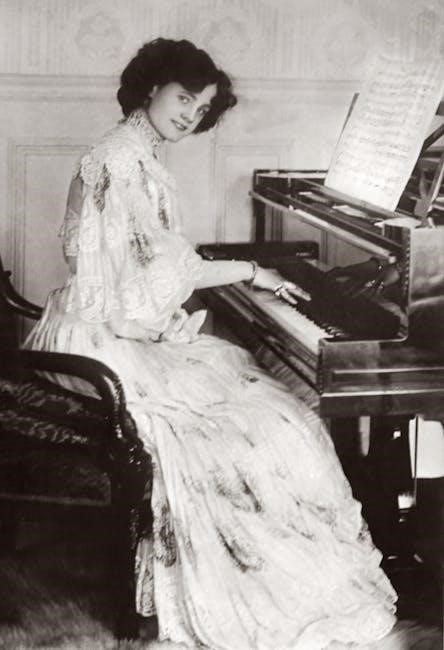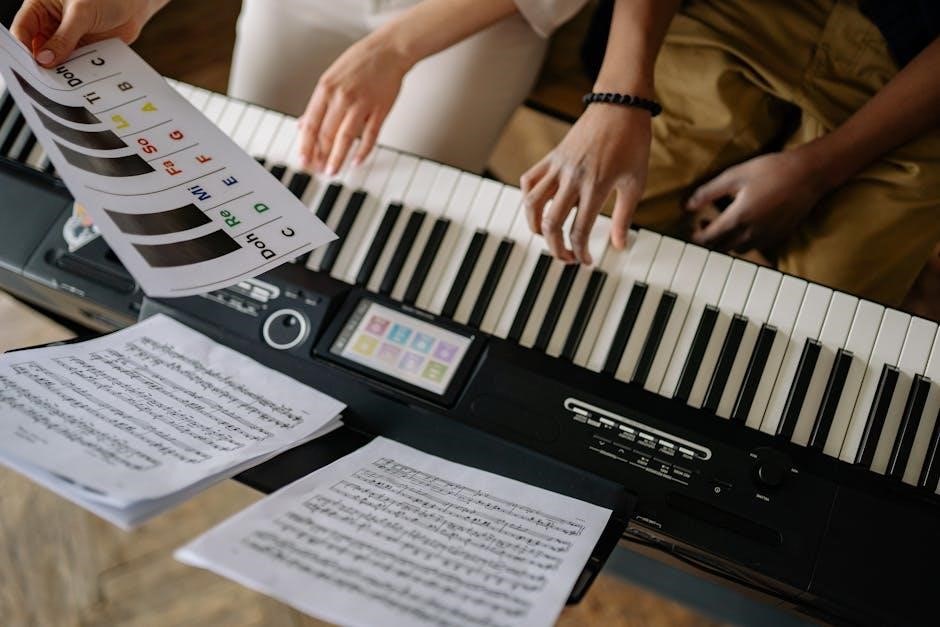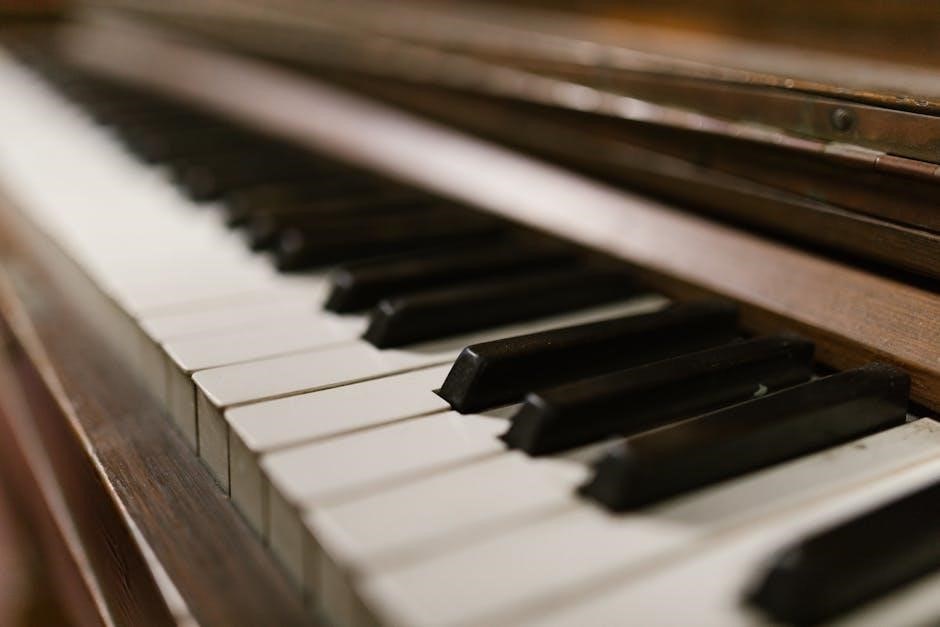bohemian rhapsody sheet music pdf piano
Composed by Freddie Mercury, “Bohemian Rhapsody” is a iconic rock ballad known for its complex structure, blending operatic and hard rock elements. Its intricate piano arrangements and dramatic transitions make it a favorite among pianists, offering both challenge and creative expression. The song’s enduring popularity stems from its unique composition and emotional depth, making it a timeless classic in music history.
1.1 Historical Context and Composition
Bohemian Rhapsody, composed by Freddie Mercury, was released in 1975 as part of Queen’s album A Night at the Opera. The song’s unique blend of operatic vocals, ballad sections, and hard rock elements revolutionized music composition. Mercury crafted the piece on his iconic grand piano, which later sold for over $1.7 million at auction. The song’s structure defies traditional norms, featuring intricate arrangements and dramatic transitions. Its composition showcases Mercury’s genius, combining classical influences with rock, creating a timeless masterpiece. The piano’s central role in the song’s composition highlights its enduring appeal to pianists worldwide, making it a cornerstone of rock music history.
1.2 The Song’s Structure and Complexity
Bohemian Rhapsody is renowned for its unconventional structure, seamlessly transitioning between ballad, opera, and hard rock sections. The song’s complexity lies in its dynamic shifts in tempo, key, and mood, creating a dramatic narrative. The piano plays a pivotal role, with intricate arpeggios and chord progressions that demand technical skill. Its operatic middle section features layered harmonies and complex vocal arrangements, adding to the song’s grandeur. This structural innovation and musical depth have made it a challenging yet rewarding piece for pianists and musicians to interpret and perform, solidifying its reputation as a masterpiece of modern music.
1.3 Why It’s a Favorite Among Pianists
Bohemian Rhapsody captivates pianists due to its rich harmonic layers and dynamic range, offering both technical challenges and expressive freedom. The song’s intricate piano parts, from delicate arpeggios to powerful chord progressions, appeal to pianists seeking complexity. Its ability to blend classical and rock elements makes it a versatile piece for interpretation. Additionally, the emotional depth and storytelling through music resonate deeply, allowing pianists to showcase their artistry. The availability of sheet music in various arrangements further enhances its accessibility, making it a beloved choice for both professionals and enthusiasts, ensuring its enduring popularity in the piano repertoire.

Sheet Music Specifics

Bohemian Rhapsody sheet music offers intricate piano scores, diverse arrangements for various skill levels, and both free and paid versions, catering to pianists of all backgrounds and preferences.
2.1 Understanding the Piano Score
The piano score for Bohemian Rhapsody is renowned for its complexity, reflecting the song’s operatic and rock elements. It demands precise finger dexterity and dynamic control, with dramatic shifts in tempo and key. The score captures Freddie Mercury’s original piano parts, including the iconic ballad and operatic sections, transcribed for solo performance. Advanced pianists will appreciate the challenging arpeggios, chromatic runs, and layered harmonies, while beginners may find it daunting. Breaking the piece into sections and practicing slowly is recommended. The score also highlights the song’s theatricality, blending delicate melodies with powerful crescendos, making it a rewarding yet demanding piece to master.
2.2 Arrangements for Different Skill Levels
Bohemian Rhapsody sheet music is available in arrangements tailored to various skill levels, ensuring accessibility for pianists of all abilities. Beginners can start with simplified versions that reduce complexity while retaining the song’s essence. These arrangements focus on basic melodies and chord progressions, making them manageable for those with limited experience. Intermediate pianists can explore versions that introduce more intricate harmonies and dynamics, gradually building technique. Advanced players will appreciate arrangements that mirror the original composition’s complexity, featuring intricate arpeggios and operatic flourishes. This versatility allows pianists to grow with the piece, mastering it step by step while maintaining its iconic sound and emotional depth.
2.3 Free vs. Paid Versions
When searching for Bohemian Rhapsody sheet music, pianists often encounter both free and paid versions. Free versions are readily available online but may lack quality, accuracy, or completeness. They are often simplified or contain only partial arrangements, which may not capture the song’s full complexity. Paid versions, however, offer high-quality, professionally transcribed scores that include all sections of the song. These are ideal for serious musicians seeking precision and authenticity. Additionally, paid versions often come with legal guarantees, supporting the artists and creators. For those seeking a faithful reproduction of Freddie Mercury’s masterpiece, paid sheet music is the recommended choice.

Piano Arrangements
Bohemian Rhapsody offers a variety of piano arrangements, from solo versions to duets and ensembles. These arrangements cater to different skill levels, ensuring accessibility for pianists of all backgrounds.
3.1 Solo Piano Versions
The solo piano versions of Bohemian Rhapsody are a testament to the song’s versatility. These arrangements allow pianists to capture the essence of the original track, blending operatic and rock elements seamlessly. The piano version emphasizes intricate arpeggios, powerful chord progressions, and dynamic shifts, mirroring Freddie Mercury’s iconic vocal performance. Many arrangements maintain the song’s original complexity, while others simplify certain sections to make it accessible for intermediate pianists. The solo format highlights the piano’s ability to replicate the layered instrumentation of the original recording, offering a challenging yet rewarding experience for musicians. This arrangement remains a favorite for its emotional depth and technical brilliance.
3.2 Duet and Ensemble Arrangements
Duet and ensemble arrangements of Bohemian Rhapsody offer a fresh, collaborative approach to the iconic song. These versions divide the intricate composition between multiple pianists, allowing for a dynamic interplay of melodies and harmonies. Duet arrangements often split the workload, with one pianist handling the main theme while the other manages accompaniments or counterpoints. Ensemble versions, involving three or more players, can replicate the song’s layered complexity more faithfully. These arrangements are perfect for group performances, fostering teamwork and creativity. They also provide an opportunity to explore the song’s dramatic shifts in tone and tempo collectively. Such collaborative renditions add a new dimension to the piano interpretation of Bohemian Rhapsody.
3.3 Simplified vs. Original Complexity
Pianists often face a choice between simplified and original complexity when playing Bohemian Rhapsody. The original sheet music mirrors the song’s intricate composition, with dramatic shifts in tempo, tone, and style. This complexity challenges even advanced pianists, making it a rewarding yet demanding piece. Simplified arrangements, however, streamline the music, reducing technical demands while preserving the song’s essence. These versions are ideal for beginners or those seeking a more accessible experience. While the original complexity captures Freddie Mercury’s visionary genius, simplified adaptations ensure broader accessibility, allowing pianists of all levels to enjoy and perform this iconic piece.

Downloading “Bohemian Rhapsody” Sheet Music
Downloading Bohemian Rhapsody sheet music is straightforward, with options for piano scores available online. Fans can access both free and paid versions, ensuring accessibility for all skill levels. Legal downloads are encouraged to support artists and comply with copyright laws. Many platforms offer high-quality PDFs, making it easy for pianists to acquire and print the music. This convenience has made the song a popular choice for both practice and performance, maintaining its timeless appeal among musicians worldwide.
4.1 Reliable Sources for PDF Downloads
When searching for Bohemian Rhapsody sheet music in PDF format, it’s essential to use trusted sources to ensure quality and legality. Websites like Musicnotes, Sheet Music Plus, and Piano Nanny offer officially licensed versions, guaranteeing accurate arrangements. These platforms provide high-quality, printable scores that cater to pianists of all levels. Some sites also offer free versions, though these may be simplified or require registration. Always verify the source’s credibility to avoid unauthorized or low-quality downloads. Reliable sources ensure that you receive a professional-grade piano score, making your practice and performance of Bohemian Rhapsody a rewarding experience.
4.2 Legal Considerations
Downloading Bohemian Rhapsody sheet music requires adherence to copyright laws. The song is copyrighted by Queen, so only licensed sources can legally distribute it. Using unlicensed versions may infringe on intellectual property rights, potentially leading to legal consequences. Always opt for reputable platforms that offer official sheet music, ensuring you support the artists and creators. Free downloads from unreliable sources may violate copyright and contribute to piracy; Respect the rights of Freddie Mercury and Queen by choosing legal options, which also ensure high-quality, accurate scores for your piano performances.
4.3 Converting Sheet Music to PDF
Converting Bohemian Rhapsody sheet music to PDF ensures compatibility and readability across devices. This format preserves the layout and quality of the score, making it ideal for sharing and printing. To convert, use software like Adobe Acrobat or online tools that support sheet music formats. Some platforms offer direct PDF downloads, eliminating the need for conversion. Always ensure the source is legal to avoid copyright issues. Once converted, the PDF can be easily accessed on tablets, phones, or computers, providing flexibility for practice and performance. This method is popular among pianists for its convenience and reliability in maintaining the song’s intricate details.

Learning to Play “Bohemian Rhapsody” on Piano
Mastering Bohemian Rhapsody on piano requires dedication and practice. Break the song into sections, focus on complex transitions, and emphasize both technical skill and emotional expression.
5.1 Tips for Beginners
Beginners should start by breaking Bohemian Rhapsody into manageable sections. Focus on the intro and verses first, as they are more accessible. Practice at a slower tempo to build confidence and dexterity; Simplify complex passages initially, gradually incorporating dynamics and articulation. Use online tutorials or sheet music with fingerings to guide hand placement. Emphasize proper posture and hand positioning to avoid fatigue. Break down challenging arpeggios and chord progressions into smaller exercises. Listen to the original recording repeatedly to internalize the rhythm and phrasing. Celebrate small progress and stay patient, as mastery takes time.
5.2 Advanced Techniques
Advanced pianists tackling Bohemian Rhapsody should focus on mastering the operatic section’s dramatic shifts and intricate arpeggios. The rock outro requires precise execution of fast arpeggiated chords and dynamic phrasing. Pay attention to the transition between sections, ensuring seamless tempo changes and articulation. Advanced players can explore nuanced pedal control to enhance resonance and texture. Practice the challenging polyrhythms and chromatic passages with metronomic accuracy. Isolate difficult measures, such as the operatic solo, and gradually increase tempo. Emphasize expressive dynamics and rubato to capture the song’s emotional depth. Study Freddie Mercury’s original piano parts for inspiration and authenticity in interpretation.
5.3 Practice Strategies
Mastering Bohemian Rhapsody requires structured practice. Start by breaking the piece into sections, focusing on one at a time. Use a metronome to maintain consistent tempo, especially during complex time signature changes. Isolate difficult measures, such as the operatic arpeggios, and practice them slowly before gradually increasing speed. Incorporate dynamic contrasts and expressive phrasing to capture the song’s emotional depth. Practice hands separately before combining them, ensuring synchronization. Record sessions to track progress and identify areas needing improvement. Prioritize consistency and patience, as the piece’s complexity demands dedicated, focused effort. Over time, these strategies will help pianists achieve a polished performance.

The Role of Freddie Mercury’s Piano
Freddie Mercury’s piano was central to ‘Bohemian Rhapsody,’ providing the harmonic foundation and emotional depth that defined the song’s complex composition and incredible appeal.
6.1 The Iconic Instrument
Freddie Mercury’s piano, a Steinway, was a cornerstone of “Bohemian Rhapsody.” Its rich, resonant sound captured the song’s dramatic shifts, from delicate melodies to powerful crescendos. Mercury’s mastery of the instrument allowed him to blend classical techniques with rock flair, creating a unique sonic identity. The piano’s versatility and expressive range were pivotal in shaping the track’s emotional depth and complexity. For pianists, the sheet music reflects this duality, offering both intricate arrangements and opportunities for artistic interpretation. The instrument’s legacy endures, inspiring musicians to explore its limitless possibilities, making it a timeless symbol of Mercury’s genius and the song’s enduring appeal.
6.2 Its Contribution to the Song
The piano played a pivotal role in shaping the identity of “Bohemian Rhapsody,” serving as both a melodic foundation and a dynamic force. It bridged the song’s operatic and rock elements, creating a seamless transition between contrasting sections. The instrument’s versatility allowed for delicate arpeggios, powerful chords, and intricate harmonies, adding depth and complexity. Freddie Mercury’s virtuosic playing brought the composition to life, blending classical influences with modern rock. The piano’s prominence elevated the track’s emotional impact, making it a cornerstone of the song’s enduring appeal. Its contribution is evident in the sheet music, which captures the intricate interplay of melody and rhythm.
6.3 Preservation and Legacy
Freddie Mercury’s piano has been meticulously preserved, with the original instrument displayed at Queen’s studio, highlighting its historical significance. The piano’s legacy endures as an iconic symbol of musical innovation, inspiring countless pianists. Its role in “Bohemian Rhapsody” has cemented its place in rock history, with the sheet music remaining a sought-after resource for musicians. The piano’s cultural impact continues to grow, ensuring its influence spans generations. As a testament to Mercury’s genius, the instrument remains a cherished artifact, celebrating the song’s timeless appeal. Its legacy is a reminder of the power of music to transcend time and inspire creativity.

“Bohemian Rhapsody” in Popular Culture
The song’s enduring influence is evident in films, TV shows, and media, with its iconic appearance in Wayne’s World reigniting its popularity. Its unique structure and theatricality have inspired countless covers, parodies, and references, solidifying its status as a cultural phenomenon. Bohemian Rhapsody continues to captivate audiences, proving its timeless appeal across generations and genres.
7.1 Impact on Music and Film
Bohemian Rhapsody’s innovative blend of opera and rock revolutionized music videos and film soundtracks. Its inclusion in Wayne’s World (1992) and the biopic Bohemian Rhapsody (2018) showcased its enduring appeal. The song’s dramatic structure and emotional depth have inspired countless artists and filmmakers, making it a cultural touchstone. Its influence extends to various genres, with many musicians and composers drawing inspiration from its complexity. The track’s ability to transcend time and genres has solidified its legacy, ensuring its continued relevance in both music and cinematic contexts. Its impact remains unparalleled, with its sheet music sought after by pianists worldwide.
7.2 Covers and Remixes
Bohemian Rhapsody has inspired countless covers and remixes, showcasing its versatility. Artists like Elton John, Axl Rose, and Pentatonix have delivered memorable renditions, while electronic and instrumental versions, such as piano covers, have emerged. The song’s complex structure makes it a favorite for creative reinterpretations. Its sheet music, particularly for piano, has been adapted into simplified and intricate arrangements, allowing pianists of all levels to explore its depth. These covers and remixes highlight the track’s timeless appeal and its ability to transcend genres, ensuring its continued relevance in modern music culture. Each interpretation pays homage to the original while adding a fresh perspective.
7.3 Cultural Significance
Bohemian Rhapsody holds immense cultural significance as a groundbreaking piece in music history. Its innovative composition and theatrical style redefined rock music, influencing countless artists. The song’s dramatic structure, blending opera and rock, captivated audiences globally. Its iconic music video, one of the first to tell a story, set a new standard for visual artistry. The piano’s role in the song, particularly its intricate solos, has made it a beloved piece for pianists worldwide. Its enduring popularity, from its 1975 release to its resurgence in films like Wayne’s World, solidifies its place as a cultural phenomenon and timeless musical masterpiece.

Sheet Music for Other Instruments
Bohemian Rhapsody sheet music is available for various instruments, including guitar, vocals, and orchestral arrangements, catering to diverse musical preferences and skill levels.
8.1 Guitar Tabs
Guitar tabs for “Bohemian Rhapsody” are widely available, offering detailed finger placements for the song’s intricate riffs and chords. The tabs cater to both beginners and advanced players, with simplified versions focusing on the iconic intro and outro, while more complex tabs capture Brian May’s unique playing style. These resources often include annotations for techniques like harmonics and orchestral layering, making them invaluable for musicians aiming to replicate the song’s grandeur. Many websites provide free and paid tabs, ensuring accessibility for all skill levels. Guitarists can explore various arrangements, from solo performances to full-band covers, enhancing their musical versatility and creativity.
8.2 Vocal Scores
Vocal scores for “Bohemian Rhapsody” capture the song’s iconic harmonies and operatic sections, offering detailed notation for soloists and choirs. These scores highlight Freddie Mercury’s dynamic vocal range, from soft ballad-like passages to powerful operatic crescendos. They often include multi-part harmonies, making them ideal for group performances or choral arrangements. Many vocal scores are adapted for various skill levels, ensuring accessibility for both professionals and enthusiasts. Additionally, they are frequently paired with piano accompaniments, providing a comprehensive guide for vocalists. The emotional depth and complexity of the song make its vocal scores highly sought after for both personal practice and stage performances, celebrating its enduring legacy.
8.3 Orchestral Arrangements
Orchestral arrangements of “Bohemian Rhapsody” offer a grand interpretation, blending rock and classical elements. These arrangements typically feature a full symphony, including strings, brass, and percussion, capturing the song’s dramatic shifts. The orchestration enhances the emotional depth, from the balladic intro to the operatic climax. Many arrangements remain faithful to Freddie Mercury’s composition while adding fresh layers of complexity. They are performed by orchestras worldwide, showcasing the song’s versatility. These versions are often used in concerts and tributes, paying homage to Queen’s legacy. Orchestral arrangements provide a new dimension to the classic, appealing to both classical and rock enthusiasts, ensuring its timeless appeal endures;

Resources for Musicians
Resources for musicians include tutorials, guides, and online communities. These tools aid in mastering Bohemian Rhapsody and provide support for pianists of all skill levels.
9.1 Tutorials and Guides
Tutorials and guides are essential for mastering Bohemian Rhapsody on piano. Video tutorials on YouTube and specialized music websites break down complex sections. Step-by-step guides and interactive tools help pianists of all levels. Many resources focus on specific techniques, such as Freddie Mercury’s iconic runs or operatic transitions. Detailed PDF guides often accompany sheet music, offering finger placements and tempo advice. These materials cater to both beginners and advanced players, ensuring a comprehensive learning experience. By leveraging these resources, musicians can refine their skills and faithfully recreate the song’s intricate arrangements. Practice becomes more efficient with structured guidance.
9.2 Online Communities
Online communities play a vital role in connecting pianists passionate about Bohemian Rhapsody. Forums, social media groups, and dedicated music platforms provide spaces for sharing sheet music, tips, and experiences. Reddit’s r/piano and r/Queen communities are popular hubs for discussing arrangements and techniques. Facebook groups and Discord servers also thrive, offering collaborative learning environments. These communities often share PDF resources, advice for mastering complex sections, and encouragement for performers. They foster a sense of camaraderie, helping musicians overcome challenges and refine their interpretations. Engaging with these networks can inspire and motivate pianists to achieve their best performances of this iconic piece.
9.3 Workshops and Classes
Workshops and classes dedicated to mastering Bohemian Rhapsody offer pianists structured learning opportunities. Many music schools and online platforms provide specialized courses focusing on the song’s intricate arrangements. These sessions often include hands-on instruction, breaking down complex sections like the operatic interlude or the rock ballad segments. Expert instructors guide students through advanced techniques, such as layered harmonies, arpeggios, and dynamic shifts. Workshops also emphasize performance skills, helping pianists convey the song’s emotional depth. Whether in-person or virtual, these programs create a supportive environment for pianists to refine their skills and deliver captivating performances of this iconic piece.
Bohemian Rhapsody remains a timeless masterpiece, offering pianists a rich, emotional journey. Its complexity and depth ensure endless inspiration, making it a cherished piece for all skill levels.
10.1 Final Thoughts
Bohemian Rhapsody is a masterpiece that challenges and inspires pianists of all levels. Its intricate composition and emotional depth make it a rewarding piece to learn and perform. Whether you’re a beginner or an advanced player, the sheet music offers a journey through its iconic operatic, balladic, and rock sections. The availability of both free and paid versions ensures accessibility, while the song’s cultural significance adds to its appeal. Embrace the challenge, and let Freddie Mercury’s genius guide your fingers across the keys. The satisfaction of mastering this piece is unparalleled, making it a timeless favorite for pianists worldwide.
10.2 Encouragement for Aspiring Pianists
Embarking on Bohemian Rhapsody is a rewarding journey for pianists of all levels. Its complex structure and emotional depth offer a chance to grow musically. Don’t be intimidated by its challenges—each section, from operatic to rock, is a stepping stone to mastery. Simplified arrangements are available for beginners, while advanced players can tackle the original’s complexity. Remember, every note tells a story, and Freddie Mercury’s legacy lives through your performance. Practice with patience, and let the music inspire you. Mastering this piece is a testament to your dedication and passion. Embrace the challenge and enjoy the transformative experience of playing this iconic song.
10.3 The Timeless Appeal of “Bohemian Rhapsody”
Bohemian Rhapsody continues to captivate audiences decades after its release, showcasing its enduring appeal. Its unique blend of operatic grandeur, rock intensity, and heartfelt balladry creates a musical experience unlike any other. The song’s emotional depth and theatricality resonate with listeners of all generations. For pianists, the sheet music offers a chance to explore its intricate harmonies and dynamic shifts, making it a timeless challenge and inspiration. Its adaptability to various arrangements ensures its relevance across different musical styles and skill levels. This iconic piece remains a celebration of creativity and artistry, solidifying its place as one of music’s greatest masterpieces.







Leave a Comment